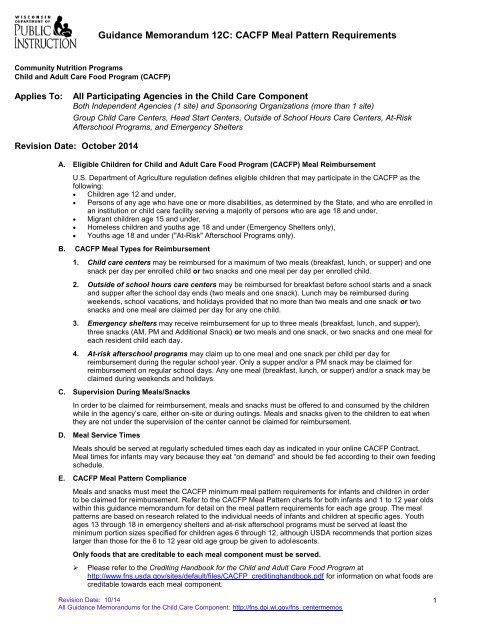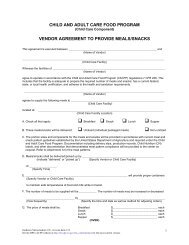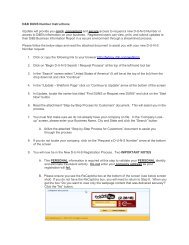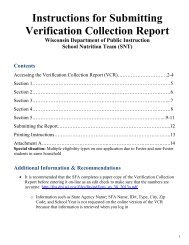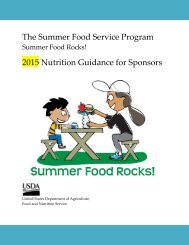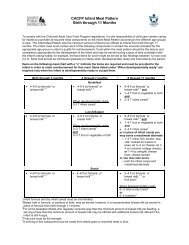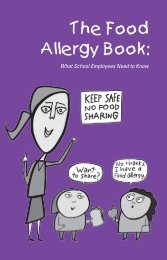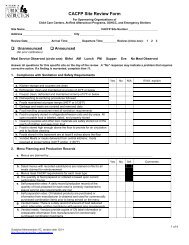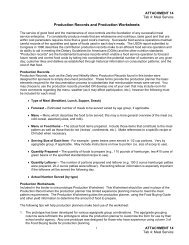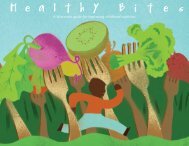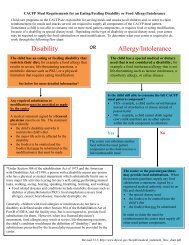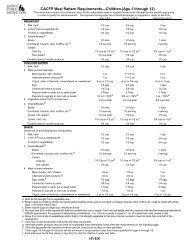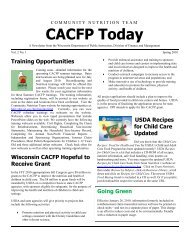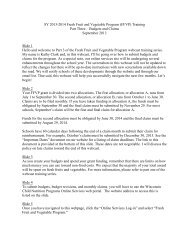Guidance Memorandum 12C - WI Child Nutrition Programs (FNS)
Guidance Memorandum 12C - WI Child Nutrition Programs (FNS)
Guidance Memorandum 12C - WI Child Nutrition Programs (FNS)
Create successful ePaper yourself
Turn your PDF publications into a flip-book with our unique Google optimized e-Paper software.
<strong>Guidance</strong> <strong>Memorandum</strong> <strong>12C</strong>: CACFP Meal Pattern RequirementsCommunity <strong>Nutrition</strong> <strong>Programs</strong><strong>Child</strong> and Adult Care Food Program (CACFP)Applies To:All Participating Agencies in the <strong>Child</strong> Care ComponentBoth Independent Agencies (1 site) and Sponsoring Organizations (more than 1 site)Group <strong>Child</strong> Care Centers, Head Start Centers, Outside of School Hours Care Centers, At-RiskAfterschool <strong>Programs</strong>, and Emergency SheltersRevision Date: October 2014A. Eligible <strong>Child</strong>ren for <strong>Child</strong> and Adult Care Food Program (CACFP) Meal ReimbursementU.S. Department of Agriculture regulation defines eligible children that may participate in the CACFP as thefollowing: <strong>Child</strong>ren age 12 and under, Persons of any age who have one or more disabilities, as determined by the State, and who are enrolled inan institution or child care facility serving a majority of persons who are age 18 and under, Migrant children age 15 and under, Homeless children and youths age 18 and under (Emergency Shelters only), Youths age 18 and under ("At-Risk" Afterschool <strong>Programs</strong> only).B. CACFP Meal Types for Reimbursement1. <strong>Child</strong> care centers may be reimbursed for a maximum of two meals (breakfast, lunch, or supper) and onesnack per day per enrolled child or two snacks and one meal per day per enrolled child.2. Outside of school hours care centers may be reimbursed for breakfast before school starts and a snackand supper after the school day ends (two meals and one snack). Lunch may be reimbursed duringweekends, school vacations, and holidays provided that no more than two meals and one snack or twosnacks and one meal are claimed per day for any one child.3. Emergency shelters may receive reimbursement for up to three meals (breakfast, lunch, and supper),three snacks (AM, PM and Additional Snack) or two meals and one snack, or two snacks and one meal foreach resident child each day.4. At-risk afterschool programs may claim up to one meal and one snack per child per day forreimbursement during the regular school year. Only a supper and/or a PM snack may be claimed forreimbursement on regular school days. Any one meal (breakfast, lunch, or supper) and/or a snack may beclaimed during weekends and holidays.C. Supervision During Meals/SnacksIn order to be claimed for reimbursement, meals and snacks must be offered to and consumed by the childrenwhile in the agency’s care, either on-site or during outings. Meals and snacks given to the children to eat whenthey are not under the supervision of the center cannot be claimed for reimbursement.D. Meal Service TimesMeals should be served at regularly scheduled times each day as indicated in your online CACFP Contract.Meal times for infants may vary because they eat “on demand” and should be fed according to their own feedingschedule.E. CACFP Meal Pattern ComplianceMeals and snacks must meet the CACFP minimum meal pattern requirements for infants and children in orderto be claimed for reimbursement. Refer to the CACFP Meal Pattern charts for both infants and 1 to 12 year oldswithin this guidance memorandum for detail on the meal pattern requirements for each age group. The mealpatterns are based on research related to the individual needs of infants and children at specific ages. Youthages 13 through 18 in emergency shelters and at-risk afterschool programs must be served at least theminimum portion sizes specified for children ages 6 through 12, although USDA recommends that portion sizeslarger than those for the 6 to 12 year old age group be given to adolescents.Only foods that are creditable to each meal component must be served.‣ Please refer to the Crediting Handbook for the <strong>Child</strong> and Adult Care Food Program athttp://www.fns.usda.gov/sites/default/files/CACFP_creditinghandbook.pdf for information on what foods arecreditable towards each meal component.Revision Date: 10/14All <strong>Guidance</strong> <strong>Memorandum</strong>s for the <strong>Child</strong> Care Component: http://fns.dpi.wi.gov/fns_centermemos1
<strong>Guidance</strong> <strong>Memorandum</strong> <strong>12C</strong>: CACFP Meal Pattern RequirementsF. The CACFP Infant Meal PatternA center must follow the Infant Meal Pattern until the infant reaches one year of age; once the infant turns oneyear of age, (s)he must be served meals that follow the CACFP Meal Pattern Requirements – <strong>Child</strong>ren (Ages 1through 12).1. Infant Meal ReimbursementIn order to claim infant meals for reimbursement, each meal and snack must contain specific componentsaccording to age group which include iron-fortified infant formula or breast milk, iron-fortified infant cereal,and other foods as shown in the CACFP Infant Meal Pattern chart.Webcast Training: The DPI webcast CACFP Infant Meal Pattern located athttp://fns.dpi.wi.gov/fns_cntwebcasts explains the CACFP Infant Meal Pattern requirements.2. Definitions from the United States Department of Agriculture (USDA) Infant—A baby from birth through 11 months (any child less than one year of age). Infant Formula—Any iron-fortified infant formula, including soy-based, intended for dietary use solely asa food for normal, healthy infants served in liquid state according to manufacturer’s recommendeddilution. Infant formula labeled low-iron or those specifically formulated for infants with inborn errors ofmetabolism or digestive or absorptive problems do not meet the infant meal pattern requirement. Amedical statement is required in order for the center to serve/claim reimbursement for infant formulasthat do not meet this definition. Infant Cereal—Any iron-fortified dry cereal specially formulated for and generally recognized as cerealfor infants that is routinely mixed with breast milk or iron-fortified infant formula prior to consumption. Developmentally Ready—An infant’s developmental readiness determines which foods should be fed,what texture the foods should be, and which feeding styles to use. All infants develop at their own rate.Although age and size often correspond with developmental readiness, these should not be used assole considerations for deciding what and how to feed infants. It is important to be aware of infants’rapidly developing mouth patterns and hand and body control so you know the appropriate food andtexture to serve them and the appropriate feeding style to use at each stage of their development. Onthe Infant Meal Pattern for ages 4 through 11 months, you will see foods listed under the categoryWhen Developmentally Ready. If an infant is developmentally ready, you must offer these foods to theinfant.3. Purchasing Infant FoodsThe USDA requires that all agencies participating in the <strong>Child</strong> and Adult Care Food Program purchase andprovide at least one infant formula and all infant foods appropriate for the age of the infant according to theInfant Meal Pattern, regardless whether the agency chooses to claim infant meals and snacks forreimbursement. It is recommended to select an infant formula that satisfies the needs of one or more of theinfants in care.4. Infant Meal Notification of Center Provided Formula and Baby FoodsThe attached CACFP <strong>Child</strong> Participation Form (PI-6077-A) or Infant Meal Notification Letter lets theparent/guardian know the specific brand of infant formula purchased and provided by the center. It alsoprovides official documentation of the parent’s/guardian’s decision to accept or decline the formula and/orinfant foods offered by the center. This document must be completed by the parent/guardian and kept onfile for each infant. Please include a copy of the CACFP Infant Meal Pattern with the CACFP <strong>Child</strong>Participation Form or Infant Meal Notification Letter prior to distributing to parents.5. Parent Provided Infant Formula/Breast MilkThe decision whether to breastfeed an infant or which type of infant formula is best for the infant is one forthe infant’s doctor and parent/guardian to make together. Therefore, parents/guardians may elect to declinethe offered infant formula and supply their own infant formula or breast milk. This must be documented onthe CACFP <strong>Child</strong> Participation Form or Infant Meal Notification Letter.Infant formula: When parents/guardians supply the infant formula and it is the only item required to beoffered to the infant, those meals/snacks may be claimed for reimbursement. Once the infant isintroduced to semi-solid foods, according to the Infant Meal Pattern, the center must purchase andprovide at least one of the semi-solid foods offered for each meal/snack in order to claim the infant’smeals/snacks for reimbursement.Breast milk: When a mother elects to breastfeed her infant at the center the meals/snacks cannot beclaimed for reimbursement unless the child is also eating semi-solid foods, according to the Infant MealPattern, and the center purchases and offers at least one of the food items. However, if breast milk isRevision Date: 10/14All <strong>Guidance</strong> <strong>Memorandum</strong>s for the <strong>Child</strong> Care Component: http://fns.dpi.wi.gov/fns_centermemos2
<strong>Guidance</strong> <strong>Memorandum</strong> <strong>12C</strong>: CACFP Meal Pattern Requirementsoffered in a bottle by center staff and it is the only item offered to an infant, those meals/snacks may beclaimed for reimbursement.6. Solid Infant FoodsThe decision to begin offering an infant solid food should be made by the infant’s doctor andparent/guardian. When the infant is 4 through 7 months old and developmentally ready for solid foods,those foods listed on the Infant Meal Pattern under When Developmentally Ready must be served to theinfant. Infants 8 through 11 months are able to eat a wider variety of solid foods as listed on the Infant MealPattern. If a parent brings in solid foods for their infant the meal can be claimed only when the meal meetsthe Infant Meal Pattern requirements and the center purchases and serves at least one of the food itemsaccording to the Infant Meal Pattern.A center may puree/grind regular food to the appropriate texture for infants. When doing so, a center mustfollow sanitary food preparation and safe food handling procedures for preparing infant food. Commercialbaby food may also be purchased, but must be in single components. For example, mixed fruits andvegetables can be purchased together in one jar, but meat/meat alternates, grains, and/or fruits/vegetablesmixed together in one jar are not creditable.Resources for Information on Creditable Infant Foods:- Crediting Infant Foods (from What’s in a Meal):http://fns.dpi.wi.gov/sites/default/files/imce/fns/pdf/credit_infant_foods.pdf- Infant Cereal Recipes: http://fns.dpi.wi.gov/sites/default/files/imce/fns/pdf/ific_recipes.pdf- Listing of Creditable Bread and Crackers for 8-11 Month Old Infants:http://fns.dpi.wi.gov/sites/default/files/imce/fns/pdf/gm_12_bread_crackers.pdfWebcast Training: The DPI webcast Creditable CACFP Infant Foods located athttp://fns.dpi.wi.gov/fns_cntwebcasts explains what infant foods are creditable according to the CACFPrequirements.7. Infant Meal RecordsInfant meal records must be maintained to document foods offered to infants and to determine which mealsare reimbursable. Foods provided by both the center and the parents must be documented. Record thetype and amount of food offered to each infant (birth through 11 months) by appropriate age category (Birththrough 3 Months, 4 Months through 7 Months, 8 Months through 11 Months) using the attached InfantMeal Record forms or other DPI-approved infant records.Agencies approved to claim greater than three meals must use the Infant Greater than Three Meal Recordforms found under <strong>Guidance</strong> <strong>Memorandum</strong> <strong>12C</strong>, the Infants section, on the Center <strong>Guidance</strong> <strong>Memorandum</strong>website (printed on the page footer, below).Webcast Training: The DPI webcast Claiming CACFP Infant Meals located athttp://fns.dpi.wi.gov/fns_cntwebcasts explains how to properly document infant meals on the Infant MealRecord forms for claiming them for reimbursement.Infants ages 8 through 11 months who are no longer following the Infant Meal Pattern andconsuming all table foods, including whole fluid milk and/or adult cereals and foods for breakfast,must have a signed medical statement on file stating these foods are appropriate. In this situation thecomplete CACFP meal pattern for 1-12 year olds must be met for each meal that is claimed. The infant canthen be counted in the regular meal counts and included on production records. Infant meal records neednot be completed for these infants.G. The CACFP Meal Pattern for <strong>Child</strong>ren ages 1 through 12 (and Older Participants Served in EmergencyShelters and At-risk Afterschool <strong>Programs</strong>)1. Meal ReimbursementIn order to claim meals for reimbursement, each meal and snack must contain specific componentsaccording to the attached CACFP Meal Pattern Requirements – <strong>Child</strong>ren (Ages 1 through 12) andAttachment A Alternate Protein Products.Webcast Training: The DPI webcast CACFP Meal Pattern located at http://fns.dpi.wi.gov/fns_cntwebcastsexplains the CACFP Meal Pattern requirements for 1-12 year olds.2. MilkFluid milk served to children who are two years of age and older must be fat-free (skim) or low-fat (1%) milk.Whole milk and reduced-fat (2%) milk cannot be served to children two years of age and older asRevision Date: 10/14All <strong>Guidance</strong> <strong>Memorandum</strong>s for the <strong>Child</strong> Care Component: http://fns.dpi.wi.gov/fns_centermemos3
<strong>Guidance</strong> <strong>Memorandum</strong> <strong>12C</strong>: CACFP Meal Pattern Requirementspart of a reimbursable meal. Fluid milk served may also be fat-free or low-fat lactose reduced milk, fatfreeor low-fat lactose free milk, fat-free or low-fat buttermilk, or fat-free or low-fat acidified milk.Whole milk is recommended to be served to children between one and two years old. Milk served must bepasteurized fluid milk that meets State and local standards and may be flavored or unflavored.3. Drinking WaterDrinking water must be made available to children upon request, including at meal times. It is not part of areimbursable meal and may not be served in place of fluid milk. It does not have to be available for childrento self-serve but can be made available in a variety of ways which include having cups available next to thekitchen sink faucet, having water pitchers and cups set out, or simply providing water to a child when it isrequested. It is advised that children not be served too much water before and during meal times; excesswater may lead to reducing the amount of food and milk consumed by the children. Water should be servedwith snacks when no other beverage is being served and in place of other high calorie, sweetenedbeverages (juice drinks, soda, sports drinks, etc.) that are served outside of meal times.4. Written, Dated MenusMenus must be maintained for all meals and snacks served to children ages 1 through 12 and olderparticipants served in child care centers, outside of school hours care centers, emergency shelters and atriskafterschool programs. All food items served as the required food components must be documented onthe menus kept on file as supporting documentation of the meals and snacks claimed for reimbursement.Any menu substitutions must be documented on the menu kept with monthly claim documentation.5. Food Production RecordsA prototype form, the Lunch/Supper and Breakfast/Snack Production Record form (PI-1488) is attached.Contact your assigned consultant to obtain forms for centers approved to claim meals other than breakfast,lunch, and one snack.All agencies, except for emergency shelters, must complete daily, dated food production records for allapproved meals and snacks served to children one year and over. Each meal service must provide, at aminimum, the serving sizes required by the CACFP Meal Pattern for each child served. Production recordsmust be completed for the purpose of planning and preparing the total amount of food that will be madeavailable to the anticipated number of children and adults participating in each meal service which willassure that the serving size requirements are met. They may also help control food cost.The amounts of whole or reduced fat (2%) milk offered to one to two year olds and low fat (1%) or fat-free(skim) milk offered for children ages two and older must be documented separately.Refer to the attached Instructions for Filling out Daily Food Production Record for how to complete theproduction record. The direct web link to these instructions is:http://fns.dpi.wi.gov/sites/default/files/imce/fns/pdf/pr_instruction_ccc.pdfWebcast Training: The DPI webcast Completing Production Records located athttp://fns.dpi.wi.gov/fns_cntwebcasts provides a basic overview of how to complete production records.You may use the Meal Requirements Calculation tool found athttp://fns.dpi.wi.gov/files/fns/xls/meal_req_calc.xls to determine the required amounts for each foodcomponent for each meal. Please note that the completion of the “Amounts Required” column isoptional for those staff who are familiar with the serving size requirements.To calculate the total amounts of each individual food item to be purchased and prepared based on therequired amounts, use either the Food Buying Guide for <strong>Child</strong> <strong>Nutrition</strong> <strong>Programs</strong> (November 2001) orthe Food Buying Guide Calculator for <strong>Child</strong> <strong>Nutrition</strong> <strong>Programs</strong> at http://fbg.nfsmi.org/.H. Serving Meals to StaffIf staff or other adults are served meals, the number of adult meals must be documented for two purposes: (1) toplan the amounts of food to prepare for assuring the required minimum serving sizes are provided to all childrenand adults to be served and (2) to account for the food cost incurred for serving these adult meals. Documentthe number of adult meals to be served on the Production Record (PI-1488) in the space provided for recordingthe “Projected Meal Counts” for adults. Meals served to staff or other adults must be identified either as programadult meals or non-program adult meals.1. Program AdultA program adult is an adult employee or volunteer who performs CACFP labor on the day a meal isserved to him or her. CACFP labor includes meal preparation, serving the meals, assisting the childrenduring meal service, cleaning up before and after meals, and performing administrative responsibilitiesRevision Date: 10/14All <strong>Guidance</strong> <strong>Memorandum</strong>s for the <strong>Child</strong> Care Component: http://fns.dpi.wi.gov/fns_centermemos4
<strong>Guidance</strong> <strong>Memorandum</strong> <strong>12C</strong>: CACFP Meal Pattern Requirementsdirectly related to the agency’s CACFP operation. CACFP funds the agency receives can be used to pay forthe cost of program adult meals. These meals cannot be claimed for CACFP reimbursement.2. Non-program AdultA non-program adult is an adult who does not perform CACFP labor on the day a meal is served to himor her. This includes van drivers, maintenance employees, parents not involved with meal preparation ormeal service, administrative staff not directly involved with the agency’s CACFP operation, and people ofthe community and visitors such as DPI or USDA officials. CACFP funds the agency receives cannot beused to pay for the cost of non-program adult meals. Other funds such as tuition or charging separatelyfor non-program meals must cover the food costs associated with serving non-program adult meals. Ifserving non-program adult meals, the agency’s financial records must account for the funds used to coverfor these associated food costs.I. Commercially Prepared, Combination Food ItemsCommercially prepared, combination food items can only be credited to the CACFP meal pattern when theactual content (i.e., meat, bread, etc.) is known and documented. Examples of such food items are pizza,corndogs, chicken nuggets, fish sticks, ravioli, and cheese sauce. In order to determine this information youmust have a <strong>Child</strong> <strong>Nutrition</strong> (CN) label or Product Formulation Statement for the item. Documentation must becurrent and retained with your agency’s CACFP records in order for these foods to count toward a reimbursablemeal.Refer to the <strong>Child</strong> <strong>Nutrition</strong> (CN) Label Requirement Information Sheet athttp://fns.dpi.wi.gov/sites/default/files/imce/fns/pdf/cnlabelhandout.pdf for further information and examples onhow to use CN label information to determine serving sizes.1. CN LabelA CN Label can be found on the product packaging. Not all commercially prepared, combination food itemswill have a CN Label as companies are not required to provide this information. The <strong>Nutrition</strong> Facts Labelfound on the package is not sufficient information to satisfy this requirement.The following is an example of what a CN label looks like:CNDocumentation of the CN label contribution information on a list of products provided by a commercialdistributor is also acceptable, as long as the products purchased by the agency are identified on the list.2. Product Formulation StatementA manufacturer’s product formulation statement states the amount of cooked lean meat/meat alternate orother component provided by the food per serving. This must include an original signature from themanufacturer. Please refer to the Crediting Handbook for the <strong>Child</strong> and Adult Care Food Program, pages73-75 for a sample product formulation statement.J. Meal Service MethodsCN000000This 1.95 oz. Fully Cooked Beef Patty provides 1.5 oz. equivalent meat/meat alternativefor the <strong>Child</strong> <strong>Nutrition</strong> Meal Pattern Requirements. (Use of this logo and statement CNauthorized by the Food and <strong>Nutrition</strong> Service, USDA 05-2010.)CNIn accordance with the CACFP Meal Pattern, all required food components, including milk, must be servedtogether at the same time in order for the meal or snack to be reimbursable.1. Pre-plated style from a line, table, or cartAll required food components in at least their minimum serving size requirements must be placed on eachchild’s serving dish(es) and within his/her drinking cup in front of him/her at the table in order for each mealto be eligible for reimbursement.2. Family-style diningA sufficient amount of prepared food must be provided in age-appropriate common serving dishes andplaced on each table. The amount prepared must provide at least the minimum required serving sizes ofeach of the meal components for all children at the table in order for the meal to be eligible forreimbursement. Each child should be encouraged to take all food items in their required minimum servingsize as they serve themselves. If a child does not take a required meal component, or takes less than thefull required serving size of each meal component, the child should be encouraged to take some of theitem(s) again. At no time will a child be forced to eat nor will any components be withheld.Revision Date: 10/14All <strong>Guidance</strong> <strong>Memorandum</strong>s for the <strong>Child</strong> Care Component: http://fns.dpi.wi.gov/fns_centermemos5
<strong>Guidance</strong> <strong>Memorandum</strong> <strong>12C</strong>: CACFP Meal Pattern Requirements3. Cafeteria-styleAll required food components in at least their minimum serving size requirements must be placed on eachchild’s meal tray while the children move through the serving line in order for each meal to be eligible forreimbursement.K. Allowed Meal Pattern Variations for Schools Participating in the National School Lunch Program (NSLP)and the CACFP for At-Risk Afterschool <strong>Programs</strong>1. NSLP Meal PatternSchools participating in the NSLP may serve meals and snacks at their At-Risk Afterschool Program sitesthat comply with the NSLP meal pattern instead of the CACFP meal pattern.2. Offer versus Serve (OVS) OptionSchools may serve meals at their At-Risk Afterschool Program sites by following the OVS option whenserving meals that follow either the CACFP or NSLP meal pattern.If serving meals by OVS using the NSLP meal pattern, the OVS option must be implemented inaccordance with the NSLP requirements.If the school is serving meals cafeteria-style and would like to serve meals by OVS using the CACFPmeal pattern, please contact your assigned nutrition program consultant for more guidance on how theOVS option must be implemented.L. Self-Preparation or Purchase of MealsMeals can be prepared at the center or already prepared meals can be purchased from a local school or othervendor. If prepared meals are purchased, the center is still responsible to make sure meals meet the mealpattern requirements. See <strong>Guidance</strong> <strong>Memorandum</strong> 4 and <strong>Guidance</strong> <strong>Memorandum</strong> 13C for more information.M. Serving Disabled <strong>Child</strong>ren over the Age of 12 YearsIn order to claim meals for disabled children over the age of 12, the center must have documentation from theappropriate regulating agency that its license or certification allows for the care of children with disabilities.N. Special Dietary NeedsThe Medical Statement Flow Chart may help in understanding the CACFP Meal Requirements for food allergies,intolerances, disabilities, and lifestyle preferences. This can be found on the guidance memorandum websiteunder GM <strong>12C</strong>, under the Special Dietary Needs section. The direct link ishttp://fns.dpi.wi.gov/files/fns/pdf/gm_12c_med_stmt.pdf.The Claiming Meals with Special Dietary Needs Flow Chart may help in determining whether your center canclaim specific meals that involve special dietary needs. This flow chart is also found on the guidancememorandum website under GM <strong>12C</strong>, under the Special Dietary Needs section. The direct link ishttp://fns.dpi.wi.gov/files/fns/pdf/claim_meals_spd_chart.pdf.1. DisabilityUSDA regulations 7 CFR Part 15b require centers to purchase and supply food substitutions or makemodifications to the standard meal patterns for meals and snacks served to children whose disabilitiesrestrict their diets. This must be supported by a statement signed by a licensed physician. The physician'sstatement must identify:the child's disability;an explanation of why the disability restricts the child's diet;the major life activity affected by the disability; andthe food or foods to be omitted from the child's diet, and the food or choice of foods that must besubstituted.However, if a physician prescribes a meal supplement that is in addition to the standard CACFP mealpattern requirements, the center is not required to purchase the supplement as part of the meal served tothe child with disabilities.The attached prototype form, Eating and Feeding Evaluation: <strong>Child</strong>ren with Special Needs (also available inSpanish), may be used to obtain the required information from the physician. It also describes “disability”and “major life activity” in more detail.Revision Date: 10/14All <strong>Guidance</strong> <strong>Memorandum</strong>s for the <strong>Child</strong> Care Component: http://fns.dpi.wi.gov/fns_centermemos6
<strong>Guidance</strong> <strong>Memorandum</strong> <strong>12C</strong>: CACFP Meal Pattern Requirements2. Food Allergies and IntolerancesThe center may provide food substitutions, at their discretion, for individual children who have specialdietary needs due to medical reasons but which are not a disability or the result of a disability. Thisprovision covers those children who have food intolerances or allergies but do not have life-threateningreactions (anaphylactic reactions) when exposed to the food(s) to which they have problems. However,when a licensed physician assesses that food allergies may result in severe, life-threatening reactions theallergy is considered a disability.The attached prototype form Eating and Feeding Evaluation: <strong>Child</strong>ren with Special Needs or comparablestatement must be completed by a recognized medical authority to obtain the required information for thesechildren. The statement must explain the medical condition and indicate the food(s) to be omitted and foodsthat may be substituted.Parents or guardians may supply food substitutions in these cases, and the center may claim the children’smeals for reimbursement only when the children have a written statement from a recognized medicalauthority on file at the center which supports that special dietary need and the center supplies the otherrequired meal components.The following have been identified as medical authorities in Wisconsin, based on Wisconsin Statutes,Chapter 146.81: Physician Physical Therapist Licensed Nurse Registered Dietitian Respiratory Care Practitioner Speech and Language Pathologist Chiropractor3. Lifestyle Preferences or other Parent Provided FoodsIf parents/guardians supply foods to be served to their children in place of foods provided by the center, dueto lifestyle preferences or other reasons including when a child does not like what is on the menu, thecenter cannot claim those meals for reimbursement unless justified by a medical statement signed by arecognized medical authority which lists the foods to be omitted as well as appropriate substitutions.Lifestyle preferences include, but are not limited to, eating vegetarian or organic foods or eliminating certainfoods for religious reasons. If the child does not have a medical statement on file, the center may only claimthese children’s meals for reimbursement if it purchases and supplies the parent requested substitute(s),the substitute(s) are creditable items, and the meals served do not exclude any required componentsaccording to the CACFP Meal Pattern. The exception to this rule is with non-dairy milk substitutes.Revision Date: 10/14All <strong>Guidance</strong> <strong>Memorandum</strong>s for the <strong>Child</strong> Care Component: http://fns.dpi.wi.gov/fns_centermemos7
<strong>Guidance</strong> <strong>Memorandum</strong> <strong>12C</strong>: CACFP Meal Pattern Requirements4. Non-Dairy Milk SubstitutionsParents or guardians may request in writing that their child who is one year and older be served a non-dairymilk substitution without providing a medical statement. This written request must identify the medical orother special dietary need (i.e. lifestyle choice) that restricts the diet of the child, and it is recommended thatthe request also list the name of the non-dairy milk substitution to be used.The non-dairy milk substitution must be nutritionally equivalent to milk and meet the nutritional standards forfortification of calcium, protein, vitamin A, vitamin D, and other nutrients to levels found in cow’s milk, asoutlined in the National School Lunch Program (NSLP) regulations in order to be part of a reimbursablemeal. Because the <strong>Nutrition</strong> Facts Label on food products does not list all the required nutrients (seebelow), the center will need to request documentation from the product manufacturer to confirm and certifythe presence of all required nutrients at the proper level in order to claim meals served with a non-dairy milksubstitute.Non-dairy milk substitutions must at minimum, have the required levels of the listed nutrients per cup inorder to be served as part of a reimbursable meal:Milk Substitute <strong>Nutrition</strong> StandardsNutrient Per CupCalcium 276 mgProtein8 gVitamin A 500 IUVitamin D 100 IUMagnesium 24 mgPhosphorus 222 mgPotassium 349 mgRiboflavin .44 mgVitamin B-12 1.1mcg (µg)A list of specific non-dairy beverages that are approved in Wisconsin to serve as milk substitutions isavailable on the guidance memorandum website, under GM <strong>12C</strong>, under the Special Dietary Needs section.You may access this list, Fluid Milk Substitutions in the <strong>Child</strong> <strong>Nutrition</strong> <strong>Programs</strong>, by going to the direct link:http://fns.dpi.wi.gov/files/fns/pdf/fluid_milk_sub_cnp.pdf.You may utilize the Non-Dairy Beverage Calculator excel document to assist in determining if a productmeets milk nutrition standards. This can be found on the guidance memorandum website under GM <strong>12C</strong>.The direct link is http://fns.dpi.wi.gov/files/fns/xls/non_dairy_tool.xlsx.A meal containing a non-dairy milk substitution supplied by the center or parent is reimbursablewhen all of the following three conditions are met:(a) a written request from the parent for the non-dairy substitute is on file,(b) the center has documentation that the non-dairy substitute meets all the required nutrient standards asdetailed above, and(c) all other required meal components are supplied by the center and documented.Meals serving non-dairy milk substitutions that are not nutritionally equivalent to milk:These meals/snacks can only be claimed when the special dietary need is the result of a disabilitysupported by medical statement signed by a licensed physician.If required components other than a non-dairy milk substitute are supplied by the parent orguardian:A medical statement signed by a recognized medical authority supporting these parent-providedfoods must be on file and the center must supply at least one component of the child’smeals/snacks to claim them for reimbursement.Revision Date: 10/14All <strong>Guidance</strong> <strong>Memorandum</strong>s for the <strong>Child</strong> Care Component: http://fns.dpi.wi.gov/fns_centermemos8


